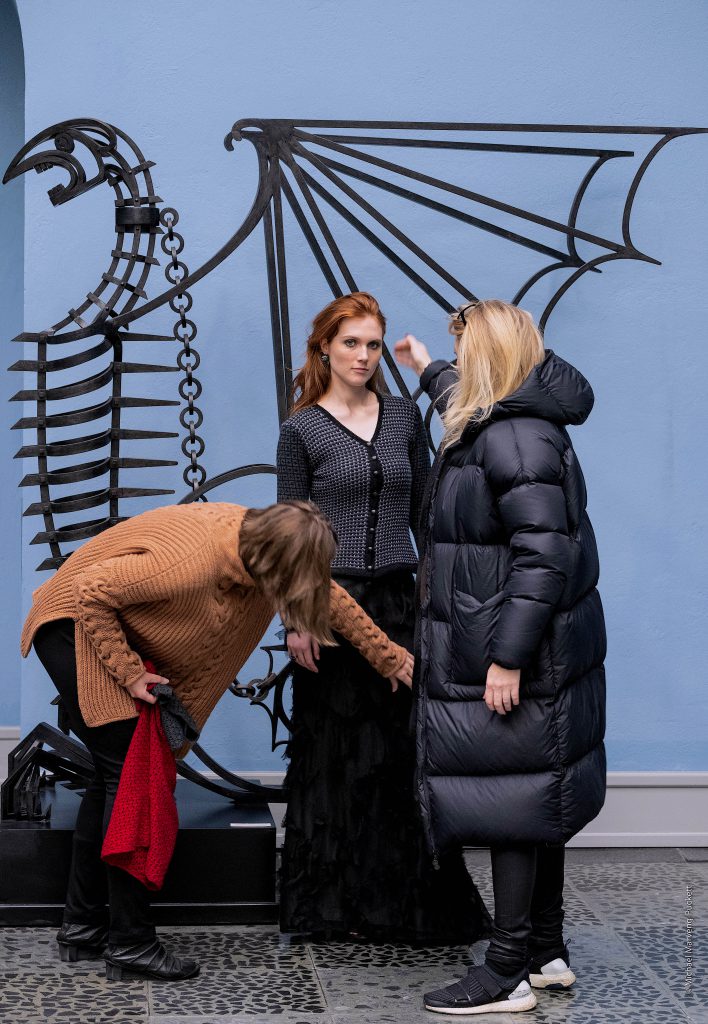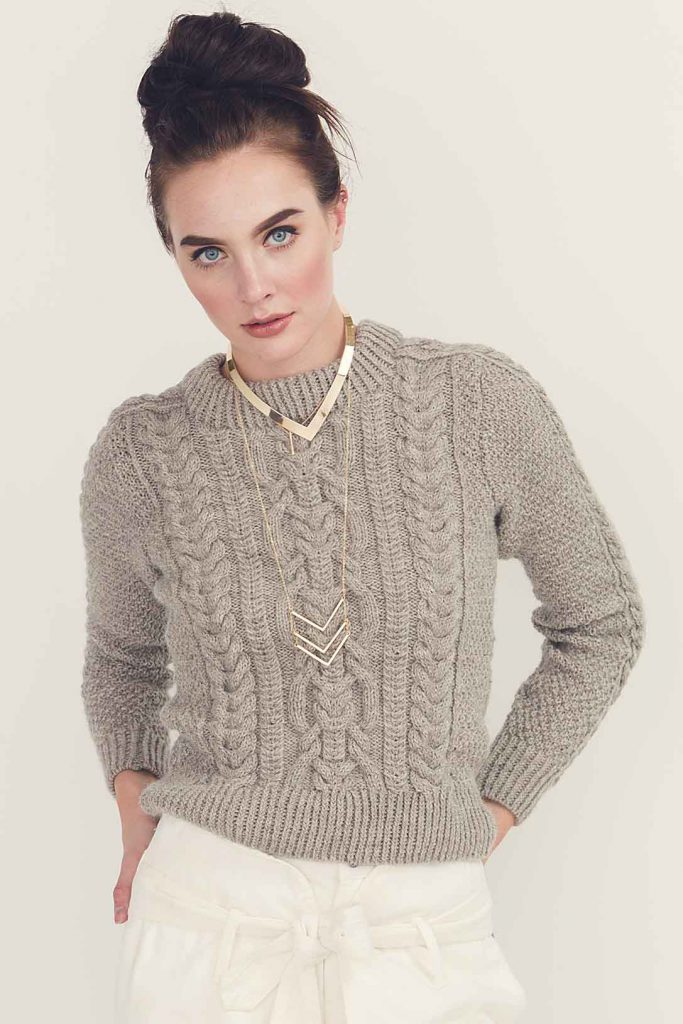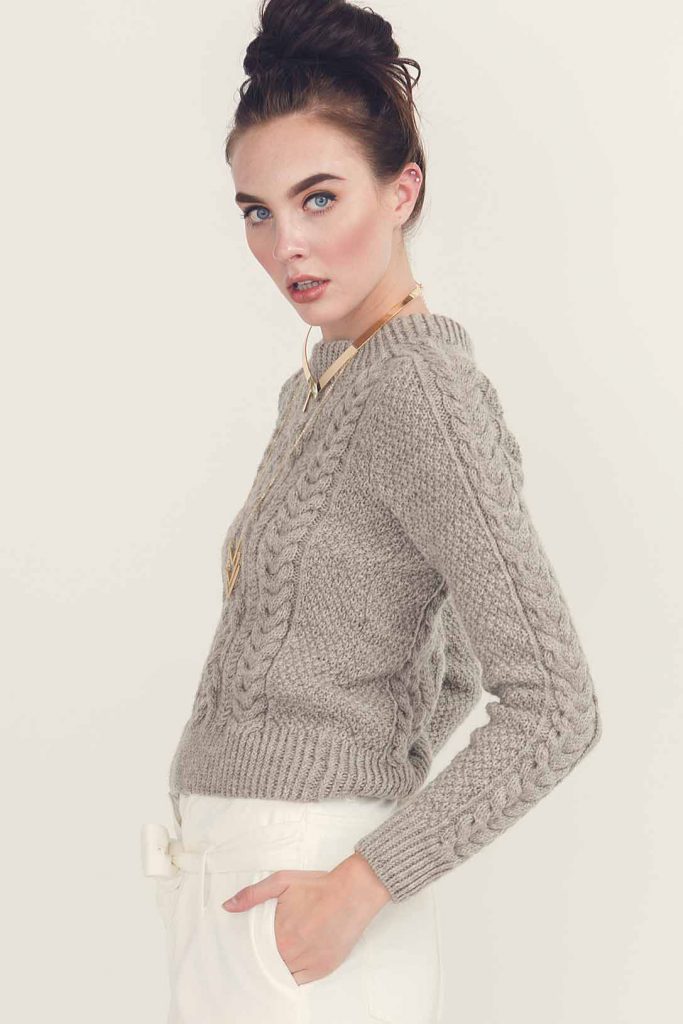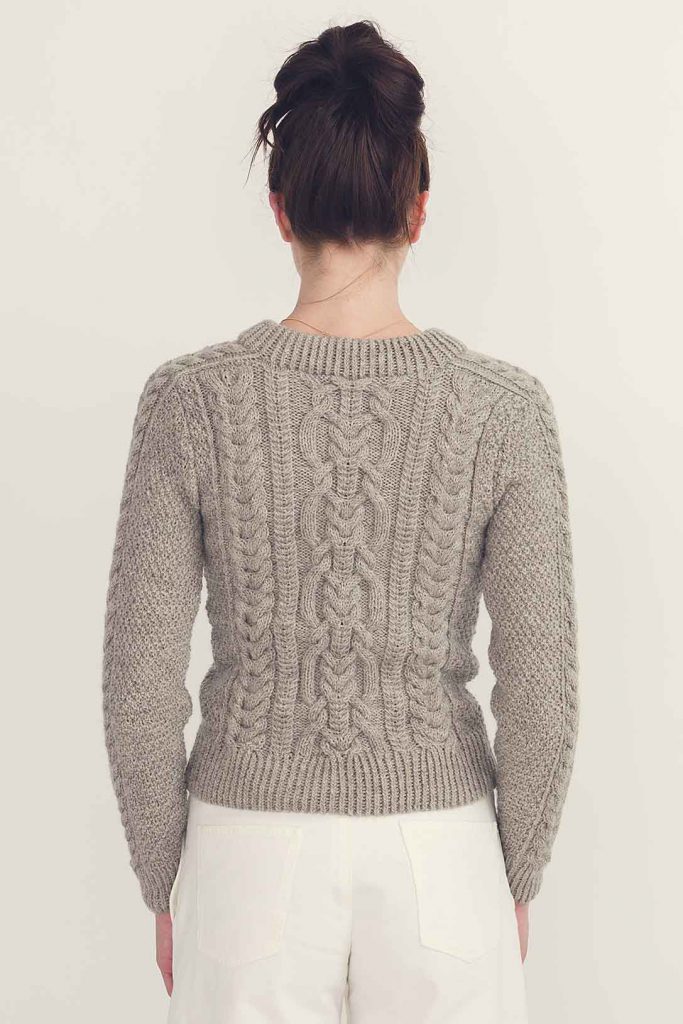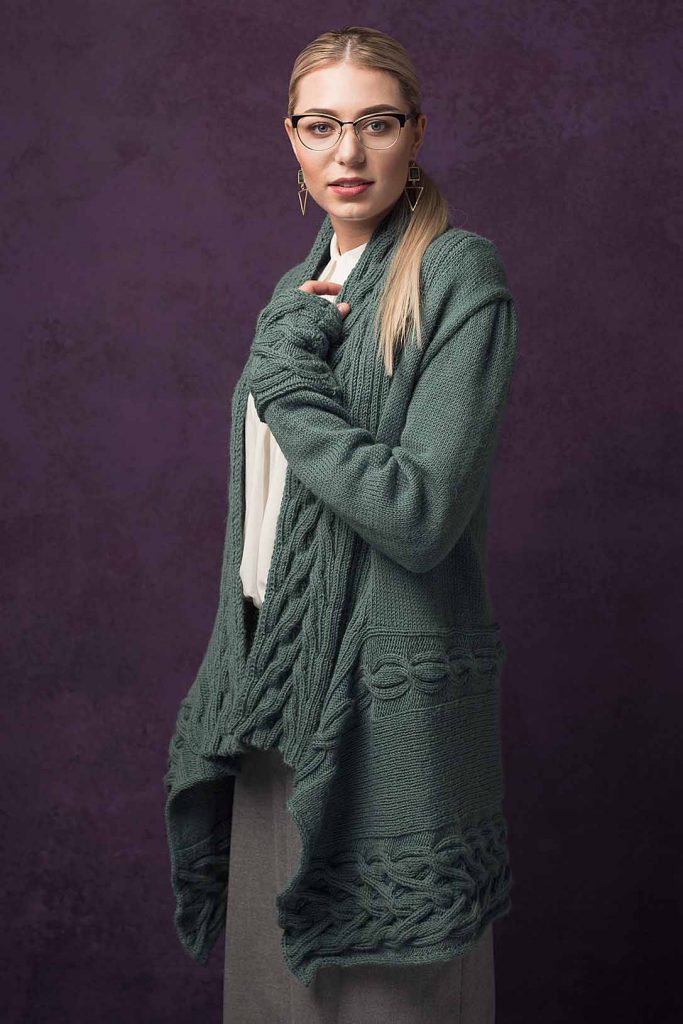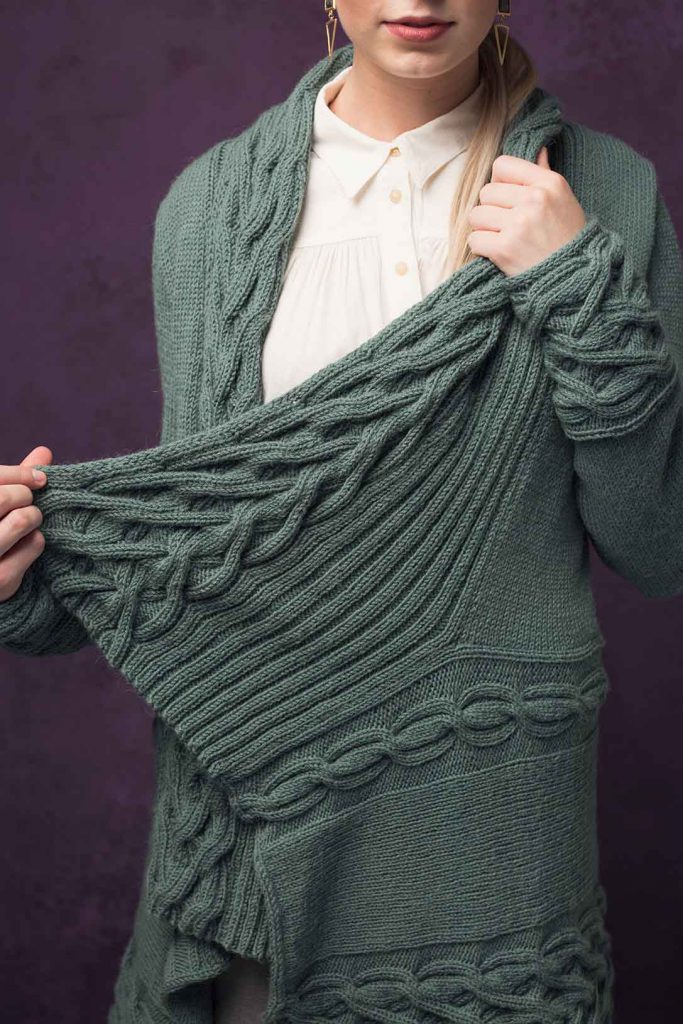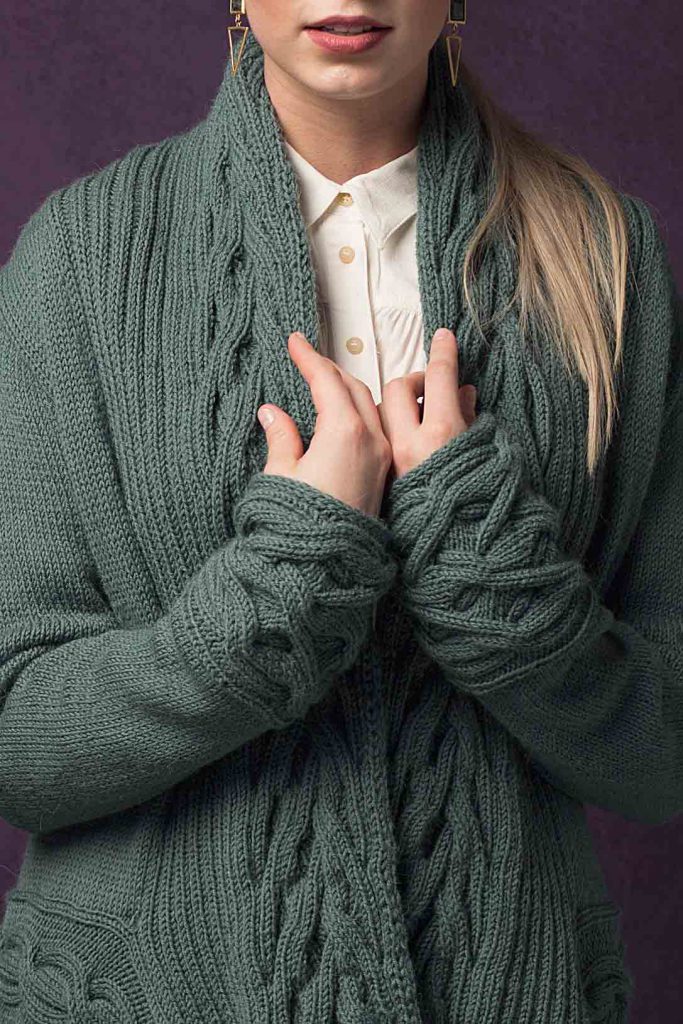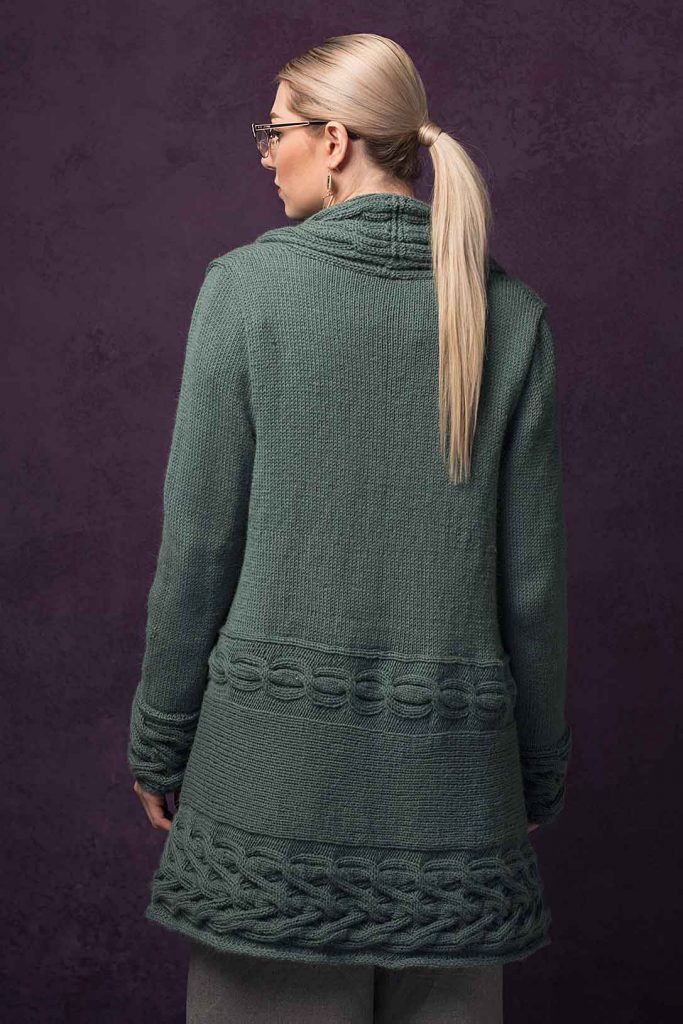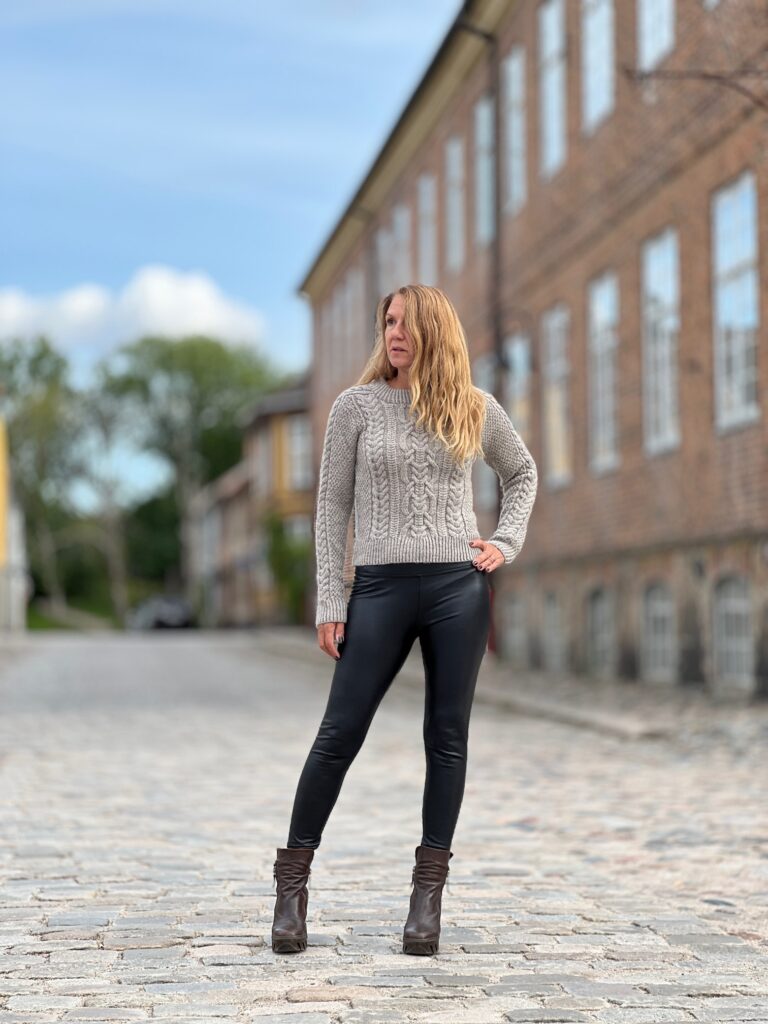 Rebekah and Gael Audic are friends from London, now living in the US, that we had not seen for more than 10 years, when they came to visit us for a few days at the beginning of September. Continue reading
Rebekah and Gael Audic are friends from London, now living in the US, that we had not seen for more than 10 years, when they came to visit us for a few days at the beginning of September. Continue reading
Tag Archives: Eira Pullover
Eira Pullover and White Mountain Ruana in Vårens Strikk
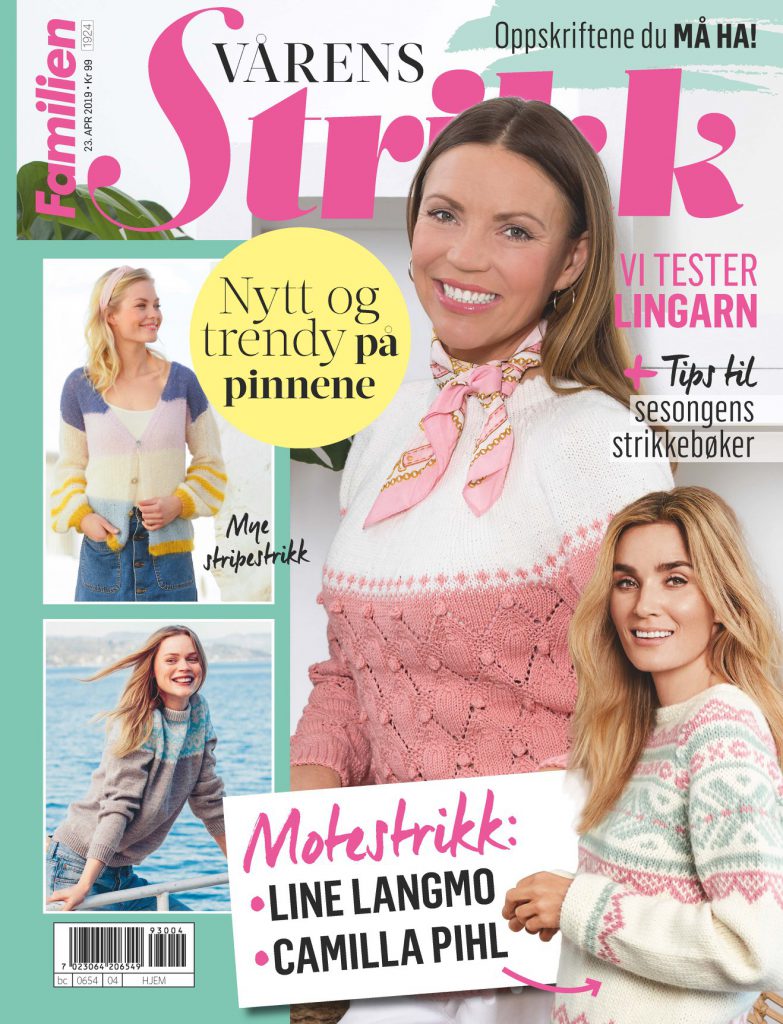 Vårens Strikk/Spring Knits is a special knitting issue published by the bimonthly magazine Familien in Norway released yesterday. I am delighted to have two designs: Eira Pullover and White Mountain Ruana as well as a brief interview in this magazine. Eira Pullover was made for knit.wear Fall/Winter 2017 and knitted in the lovely The Fibre Co. Cumbria using 4 mm/US 6 needles, while the White Mountain Ruana was made for Interweave Knits Winter 2018, knitted in the divine Shibui Knits, Maai using 4 mm/US 6 needles. Both designs were photographed for the second time around worn by the gorgeous Emma Ross, with hair & make up by Sissel Fylling and jewellery by Kaja Gjedebo Design, this time by Eivind Røhne at the Vigeland Museum in November 2018.
Vårens Strikk/Spring Knits is a special knitting issue published by the bimonthly magazine Familien in Norway released yesterday. I am delighted to have two designs: Eira Pullover and White Mountain Ruana as well as a brief interview in this magazine. Eira Pullover was made for knit.wear Fall/Winter 2017 and knitted in the lovely The Fibre Co. Cumbria using 4 mm/US 6 needles, while the White Mountain Ruana was made for Interweave Knits Winter 2018, knitted in the divine Shibui Knits, Maai using 4 mm/US 6 needles. Both designs were photographed for the second time around worn by the gorgeous Emma Ross, with hair & make up by Sissel Fylling and jewellery by Kaja Gjedebo Design, this time by Eivind Røhne at the Vigeland Museum in November 2018.
 The heading is a play on the word “flette” meaning cable in Norwegian, joined with the word “fin” meaning beautiful. Feminine garments with exciting cables is the introduction to the two patterns. The picture text is a short version of my introduction to Eira Pullover: A visually striking center cable named Kanik which is Eskimo for snowflake, adorns the center front and back on this pullover with saddle shoulders.
The heading is a play on the word “flette” meaning cable in Norwegian, joined with the word “fin” meaning beautiful. Feminine garments with exciting cables is the introduction to the two patterns. The picture text is a short version of my introduction to Eira Pullover: A visually striking center cable named Kanik which is Eskimo for snowflake, adorns the center front and back on this pullover with saddle shoulders.
 Here is the White Mountain Ruana, with part of the pattern text in Norwegian. My pages cover a total of 6 page in this special magazine which has a total of 100 pages with patterns for mainly women but also a few for men, children and babies.
Here is the White Mountain Ruana, with part of the pattern text in Norwegian. My pages cover a total of 6 page in this special magazine which has a total of 100 pages with patterns for mainly women but also a few for men, children and babies.
 The handcraft editor Åse Myhrvold Egeland, sent me a number of questions about my life in stitches such as what is your favourite pattern. I replied: “It is a difficult question. Just now, it is cables designed by the Polish designer Dorota Kowalczyk, aka devorgilla on Ravelry. I have used one of those on Corra, designed for Hillesvåg Ullvarefabrikk and their Tinde Pelsull, which is currently being test knitted”. Åse also wanted a number of photos not only of Em but also of me, so I sent her a small selection she could choose from. Michael is pleased to have his name as a photographer in the magazine. I am wearing Ataraxia, the sample I made that had to be re-knitted since the colour did not fit in together with the other designs in Pom Pom Quarterly Winter 2018 magazine. On the next page you see me wearing the dress Sigyn designed for Hillesvåg Ullvarefabrikk.
The handcraft editor Åse Myhrvold Egeland, sent me a number of questions about my life in stitches such as what is your favourite pattern. I replied: “It is a difficult question. Just now, it is cables designed by the Polish designer Dorota Kowalczyk, aka devorgilla on Ravelry. I have used one of those on Corra, designed for Hillesvåg Ullvarefabrikk and their Tinde Pelsull, which is currently being test knitted”. Åse also wanted a number of photos not only of Em but also of me, so I sent her a small selection she could choose from. Michael is pleased to have his name as a photographer in the magazine. I am wearing Ataraxia, the sample I made that had to be re-knitted since the colour did not fit in together with the other designs in Pom Pom Quarterly Winter 2018 magazine. On the next page you see me wearing the dress Sigyn designed for Hillesvåg Ullvarefabrikk.
 This special issue is for sale in newsagents and in selected super markets in Norway. If you live abroad you can order the Norwegian special magazine by e-mailing kari.bachke@egmont.com and then transfer payment into their bank account.
This special issue is for sale in newsagents and in selected super markets in Norway. If you live abroad you can order the Norwegian special magazine by e-mailing kari.bachke@egmont.com and then transfer payment into their bank account.
Photoshoot at Vigeland Museum: Eira Pullover
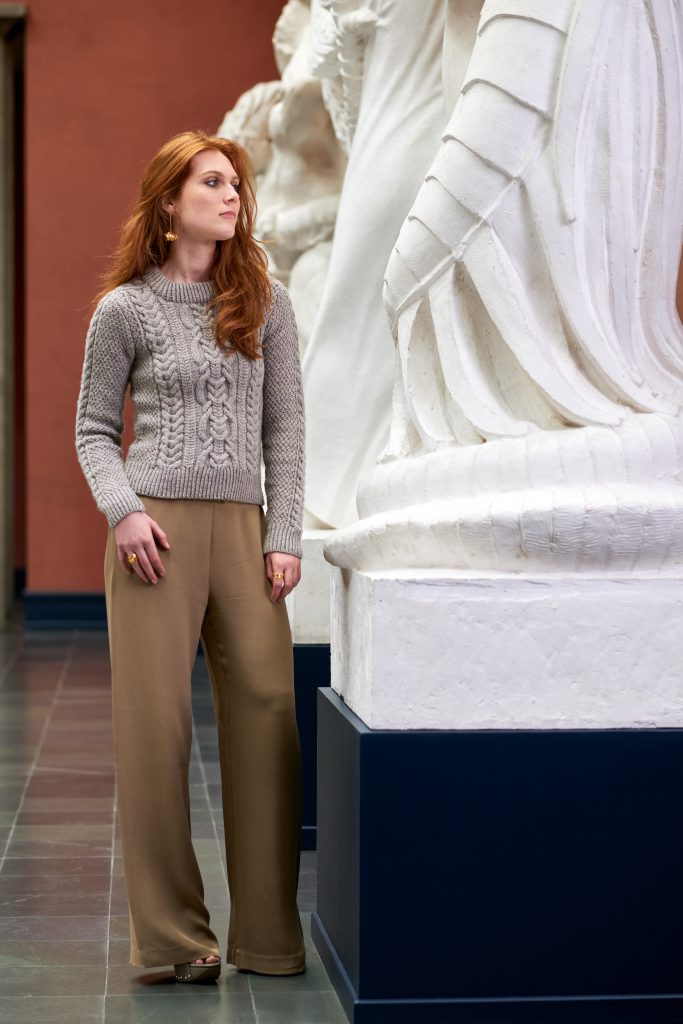 I have been looking forward to showing you more of the photos Eivind Røhne took at the Vigeland Museum in November last year. Out next is Eira Pullover, made for knit.wear Fall/Winter 2017, knitted in the divine The Fibre Co. Cumbria. Just like Nemetona, due to its light colour, I wanted to photograph this in Hall 9 with the huge plaster sculptures for the bridge in the Vigeland Park made by Gustav Vigeland in the background. Here is the gorgeous model Emma Ross, with hair & makeup by Sissel Fylling and jewellery by Kaja Gjedebo Design wearing the Eira Pullover. You can see the full sculpture in Michael’s photo in the Behind the Scenes: Photoshoot at Vigeland Museum blogpost.
I have been looking forward to showing you more of the photos Eivind Røhne took at the Vigeland Museum in November last year. Out next is Eira Pullover, made for knit.wear Fall/Winter 2017, knitted in the divine The Fibre Co. Cumbria. Just like Nemetona, due to its light colour, I wanted to photograph this in Hall 9 with the huge plaster sculptures for the bridge in the Vigeland Park made by Gustav Vigeland in the background. Here is the gorgeous model Emma Ross, with hair & makeup by Sissel Fylling and jewellery by Kaja Gjedebo Design wearing the Eira Pullover. You can see the full sculpture in Michael’s photo in the Behind the Scenes: Photoshoot at Vigeland Museum blogpost.
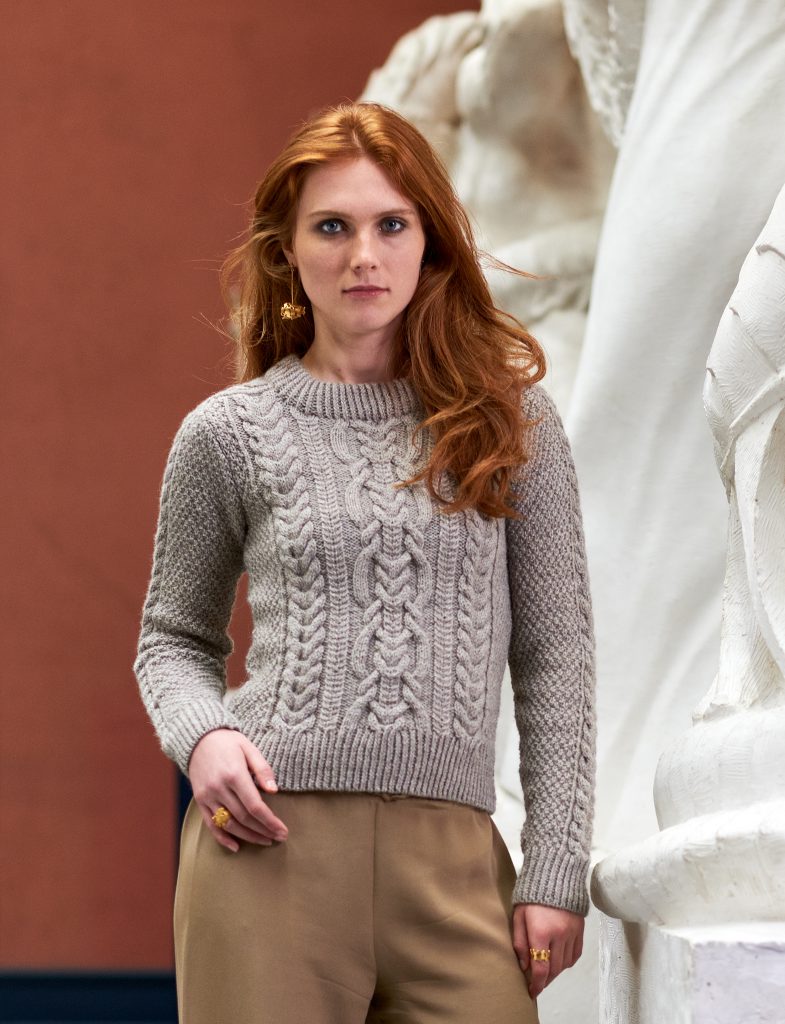 Here is my introduction to the Eira Pullover: A visually striking center cable named Kanik – Eskimo for snowflake – adorns the center front and back of this straight pullover. Kanik is framed by a staghorn cable on each side, while Moss stitch fills the background in the sides to allow the cables to shine. A saddle shoulder allows the staghorn sleeve cable to continue all the way to the neck.
Here is my introduction to the Eira Pullover: A visually striking center cable named Kanik – Eskimo for snowflake – adorns the center front and back of this straight pullover. Kanik is framed by a staghorn cable on each side, while Moss stitch fills the background in the sides to allow the cables to shine. A saddle shoulder allows the staghorn sleeve cable to continue all the way to the neck.
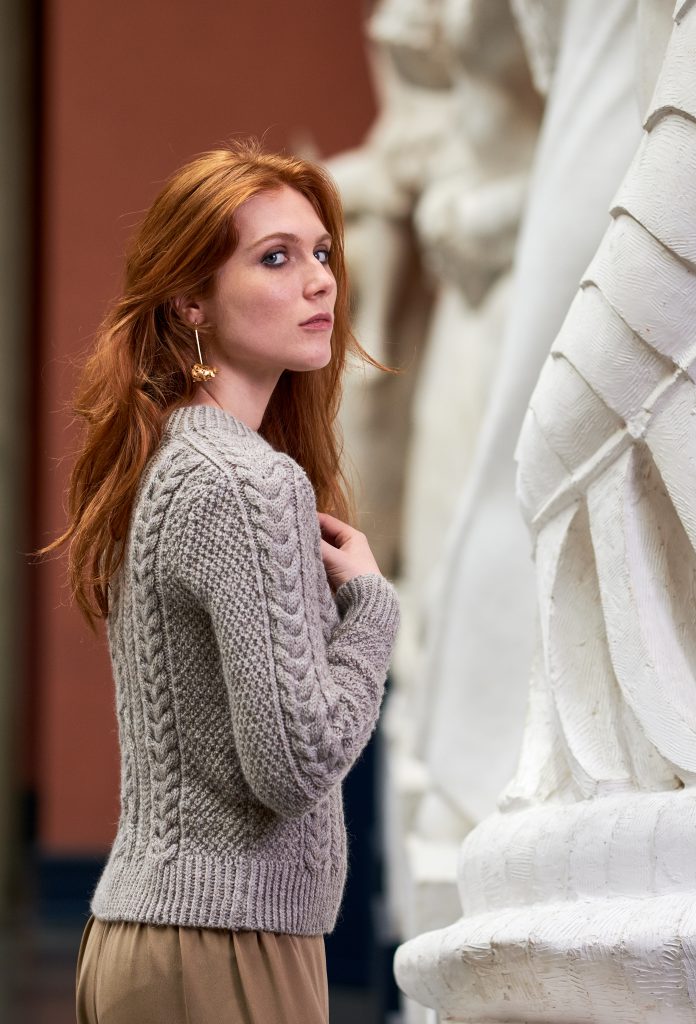 Em is wearing size XS, but the sweater is available in sizes XS to 2XL with a bust circumference of 81 to 123 cm/32 to 48.5″. I chose to style it with tan wide silk trouser after consulting with Sissel, whether to choose cream coloured ones or Judith Bech’s cream coloured skirt.
Em is wearing size XS, but the sweater is available in sizes XS to 2XL with a bust circumference of 81 to 123 cm/32 to 48.5″. I chose to style it with tan wide silk trouser after consulting with Sissel, whether to choose cream coloured ones or Judith Bech’s cream coloured skirt.
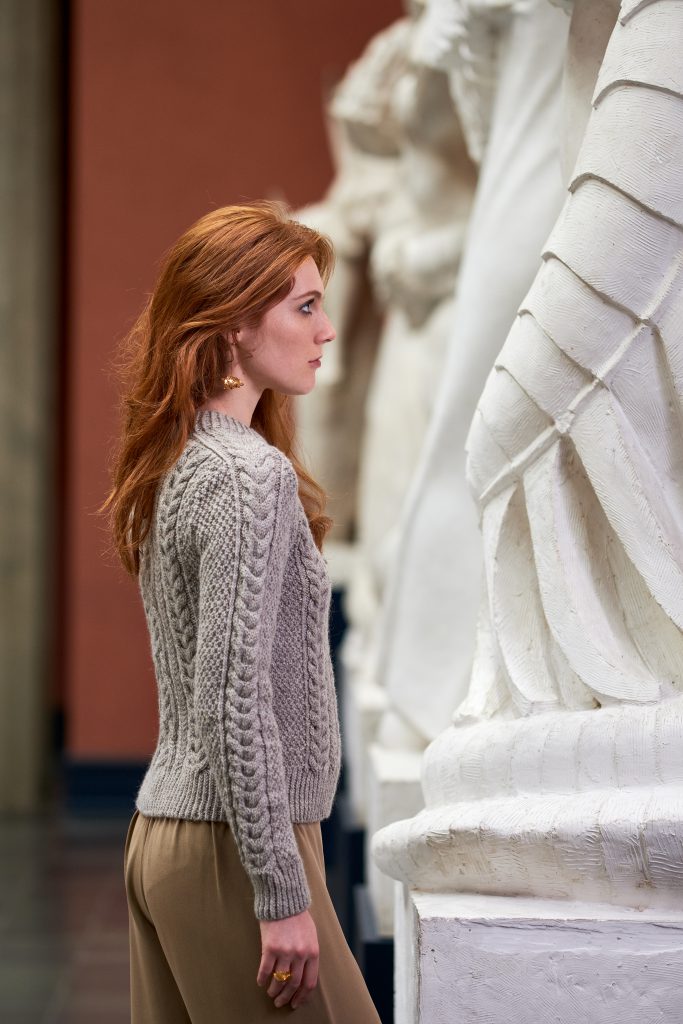 Eira Pullover is knitted in pieces in the divine The Fibre Co. Cumbria using 4 mm/US 6 needles with a gauge of 20 stitches and 28 rows in stockinette stitch measures 10 cm/4″ square. The Cumbria yarn is made of 60% merino wool, 30% brown masham wool, 10% mohair, on each 100 gram skein and has 218 meters/238 yards. I knitted the sample is in Scafell Pike and it takes 6 skeins of 100 grams to make size XS or about 1107 meters/1210 yards in a worsted or heavy DK weight yarn. I love how Em is studying the sculpture as well as how well you can see the cable on the sleeve in the photo above. Eivind and I also found this particular sculpture with the scales of the dragon such a fitting contrast to the cables.
Eira Pullover is knitted in pieces in the divine The Fibre Co. Cumbria using 4 mm/US 6 needles with a gauge of 20 stitches and 28 rows in stockinette stitch measures 10 cm/4″ square. The Cumbria yarn is made of 60% merino wool, 30% brown masham wool, 10% mohair, on each 100 gram skein and has 218 meters/238 yards. I knitted the sample is in Scafell Pike and it takes 6 skeins of 100 grams to make size XS or about 1107 meters/1210 yards in a worsted or heavy DK weight yarn. I love how Em is studying the sculpture as well as how well you can see the cable on the sleeve in the photo above. Eivind and I also found this particular sculpture with the scales of the dragon such a fitting contrast to the cables.
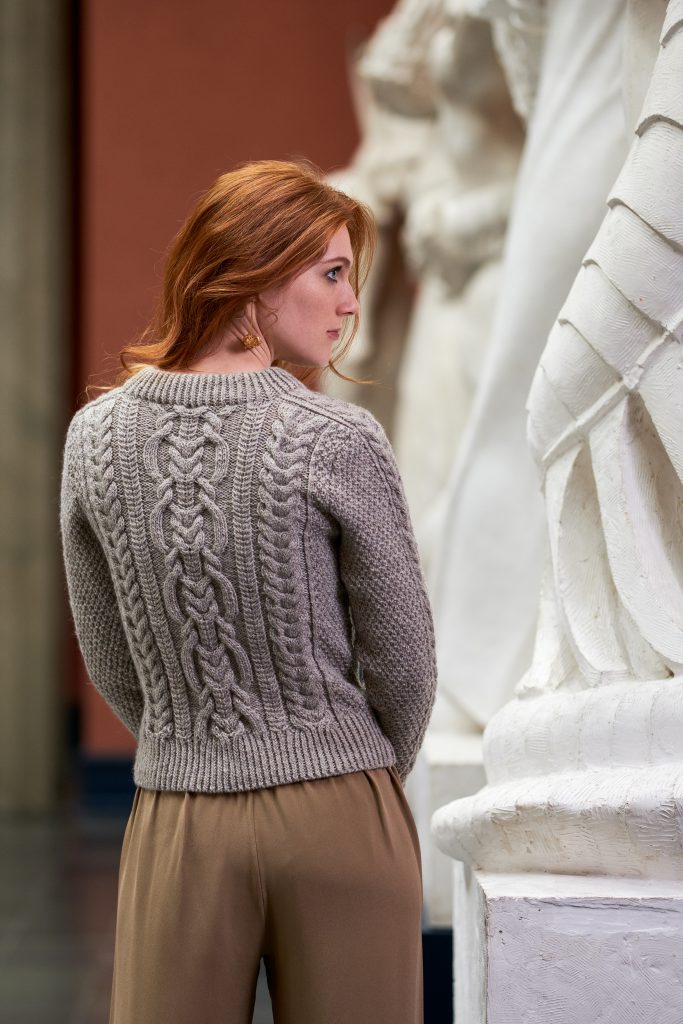 Last of the Eira Pullover photos is this one of the back. The English pattern is now available on Ravelry and on Loveknitting, as well as in the knit.wear magazine. This was the last one we photographed in Hall 9 at the Vigeland Museum, the remaining eight we photographed in the popular Monolith Hall. But I am sure we would have photographed some of those in the Fountain Hall, had it not been for the current exhibition of a contemporary artist showing an art piece we were not allowed to include in our photos, according to our contract. However, there were plenty of fantastic angles to use in the Monolith Hall. In my next blogpost from the Vigeland Museum Photoshoot I will tell you about another clause in our contract that Eivind liked to joke about. Thank you to my fantastic team! Next out is the Rørbye Cardigan.
Last of the Eira Pullover photos is this one of the back. The English pattern is now available on Ravelry and on Loveknitting, as well as in the knit.wear magazine. This was the last one we photographed in Hall 9 at the Vigeland Museum, the remaining eight we photographed in the popular Monolith Hall. But I am sure we would have photographed some of those in the Fountain Hall, had it not been for the current exhibition of a contemporary artist showing an art piece we were not allowed to include in our photos, according to our contract. However, there were plenty of fantastic angles to use in the Monolith Hall. In my next blogpost from the Vigeland Museum Photoshoot I will tell you about another clause in our contract that Eivind liked to joke about. Thank you to my fantastic team! Next out is the Rørbye Cardigan.
Behind the Scenes: Photoshoot at Vigeland Museum
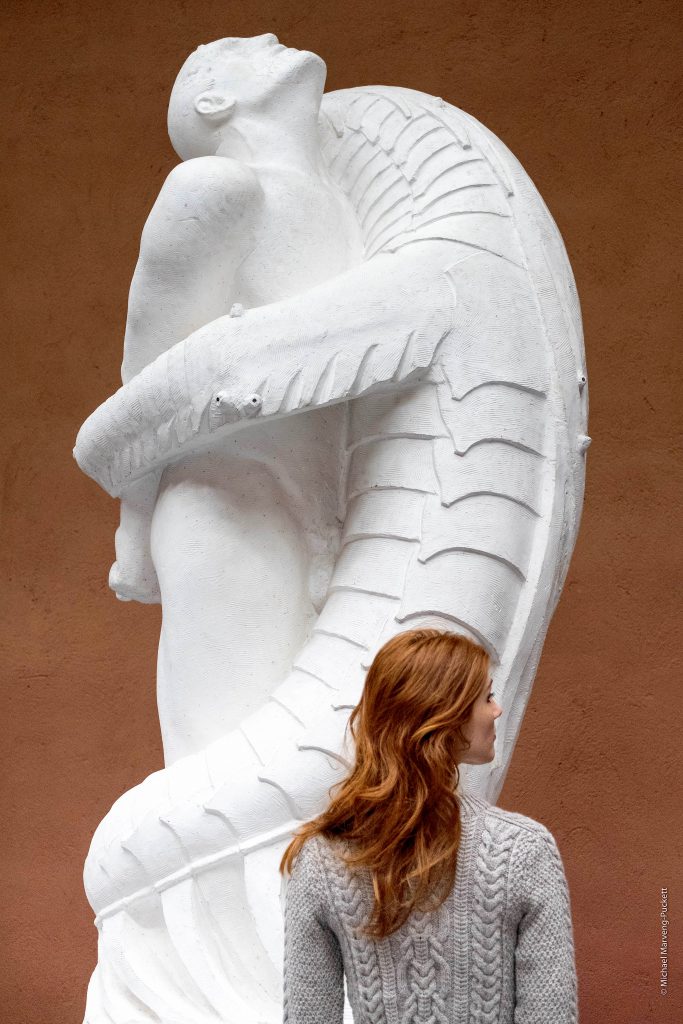 On Monday, I had a photoshoot at the Vigeland Museum, next to the Vigeland Park in Oslo. The brick building, with a majestic ceiling height, was built in the 1920’s in a Norwegian Neo Classical style. “The museum is the result of a unique contract between Gustav Vigeland and the city of Oslo signed in 1921: The Municipality agreed to build a studio, residence and future museum for the artist and his work, and in return Vigeland donated nearly all his works, previous and future, to the city”. It was with anticipation we (read my brilliant team: Photographer Eivind Røhne; Hair & Make Up Artist Sissel Fylling; Model Emma Ross; Michael; and me) were let in by one of the curators, as the museum is closed to the public on Mondays. During the day we had the chance to observe the curators at work and they us. As much as we admired their work, they enjoyed watching the beautiful garments being photographed and wondered which fashion magazine we were from. I explained that I designed handknit and that the photos were for the patterns and for the magazine Familien. Above you see gorgeous model Em, photographed by Michael in front of one of the plaster models for a sculpture to the park. Em is wearing Eira Pullover made for knit.wear Fall/Winter 2017, soon to be released in English in my Ravelry store.
On Monday, I had a photoshoot at the Vigeland Museum, next to the Vigeland Park in Oslo. The brick building, with a majestic ceiling height, was built in the 1920’s in a Norwegian Neo Classical style. “The museum is the result of a unique contract between Gustav Vigeland and the city of Oslo signed in 1921: The Municipality agreed to build a studio, residence and future museum for the artist and his work, and in return Vigeland donated nearly all his works, previous and future, to the city”. It was with anticipation we (read my brilliant team: Photographer Eivind Røhne; Hair & Make Up Artist Sissel Fylling; Model Emma Ross; Michael; and me) were let in by one of the curators, as the museum is closed to the public on Mondays. During the day we had the chance to observe the curators at work and they us. As much as we admired their work, they enjoyed watching the beautiful garments being photographed and wondered which fashion magazine we were from. I explained that I designed handknit and that the photos were for the patterns and for the magazine Familien. Above you see gorgeous model Em, photographed by Michael in front of one of the plaster models for a sculpture to the park. Em is wearing Eira Pullover made for knit.wear Fall/Winter 2017, soon to be released in English in my Ravelry store.
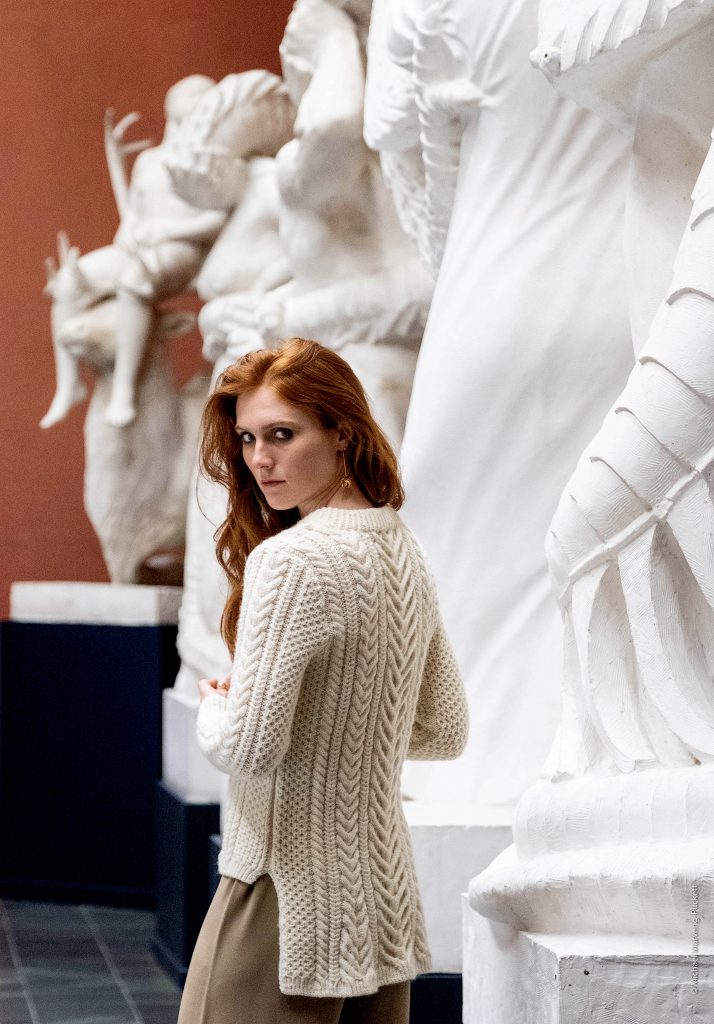 “Vigeland moved into the new building in 1924, living in the apartment on the top floor of the east wing. Here he resided and worked until his death in 1943. From the tower in this majestic red brick building he had a beautiful view towards the fields of Frogner, where his great project, the park, soon was to be reality.” We were guided into the Children’s room, were we would camp out all day. I am sure we enjoyed it as much as the children who usually visit that room! While Hair & Make up Artist Sissel was working her magic on Em, Eivind and I did a round in the museum. We picked two halls as for our shoot: Hall 9, which you see above and the Monolith Hall, which you see below. On the agenda was photographing a total of 10 garments: 4 new designs for Hillesvåg Ullvarefabrikk; 1 new design for the Norwegian magazine Familien: Nemetona; 4 returning designs from Interweave: Eira Pullover, Rørbye Cardigan, White Mountain Ruana and Andaman Top; 1 old design from my book: Tweedjakke with accessories: Duggdråpe Halser.
“Vigeland moved into the new building in 1924, living in the apartment on the top floor of the east wing. Here he resided and worked until his death in 1943. From the tower in this majestic red brick building he had a beautiful view towards the fields of Frogner, where his great project, the park, soon was to be reality.” We were guided into the Children’s room, were we would camp out all day. I am sure we enjoyed it as much as the children who usually visit that room! While Hair & Make up Artist Sissel was working her magic on Em, Eivind and I did a round in the museum. We picked two halls as for our shoot: Hall 9, which you see above and the Monolith Hall, which you see below. On the agenda was photographing a total of 10 garments: 4 new designs for Hillesvåg Ullvarefabrikk; 1 new design for the Norwegian magazine Familien: Nemetona; 4 returning designs from Interweave: Eira Pullover, Rørbye Cardigan, White Mountain Ruana and Andaman Top; 1 old design from my book: Tweedjakke with accessories: Duggdråpe Halser.
 “The museum opened in 1947, houses almost Vigeland’s entire production; sculptures in plaster, granite, bronze, marble, works in wrought iron, thousands of drawings, woodcuts and woodcarvings. In the museum you will find the original plasters to his famous busts and monuments, in addition to the plaster models to the sculptures in the Vigeland Park.” Above you can see Eivind in action, with me standing next to him and Michael just behind him. In the end we photographed nearly all of the garments, with the two exceptions you see above, in the Monolith Hall.
“The museum opened in 1947, houses almost Vigeland’s entire production; sculptures in plaster, granite, bronze, marble, works in wrought iron, thousands of drawings, woodcuts and woodcarvings. In the museum you will find the original plasters to his famous busts and monuments, in addition to the plaster models to the sculptures in the Vigeland Park.” Above you can see Eivind in action, with me standing next to him and Michael just behind him. In the end we photographed nearly all of the garments, with the two exceptions you see above, in the Monolith Hall.
The lizard in wrought iron is a model for the gates in the Vigeland Park and the most complicated of these wrought iron works Vigeland made. Their graphical presence added extra drama and was perfect for the Tweedjakke worn over Judith Bech’s wonderful skirt with a train. I was wearing the Patent Poncho, while Sissel – as you can see was cold – and wore her coat inside. To our surprise she did not cut Em’s hair this time. I had also borrowed jewellery by Kaja Gjedebo Design, as I usually do. There is no café at the museum so I had ordered catering from the nearby Eckers Cafe, with one delivery of drinks in the morning and one for lunch, so that we would not loose too much time looking for a nearby restaurant and wait for our lunch. That worked well and while we spent quite a bit of time to set up and prepare for the first garment, the remaining ones went quickly.
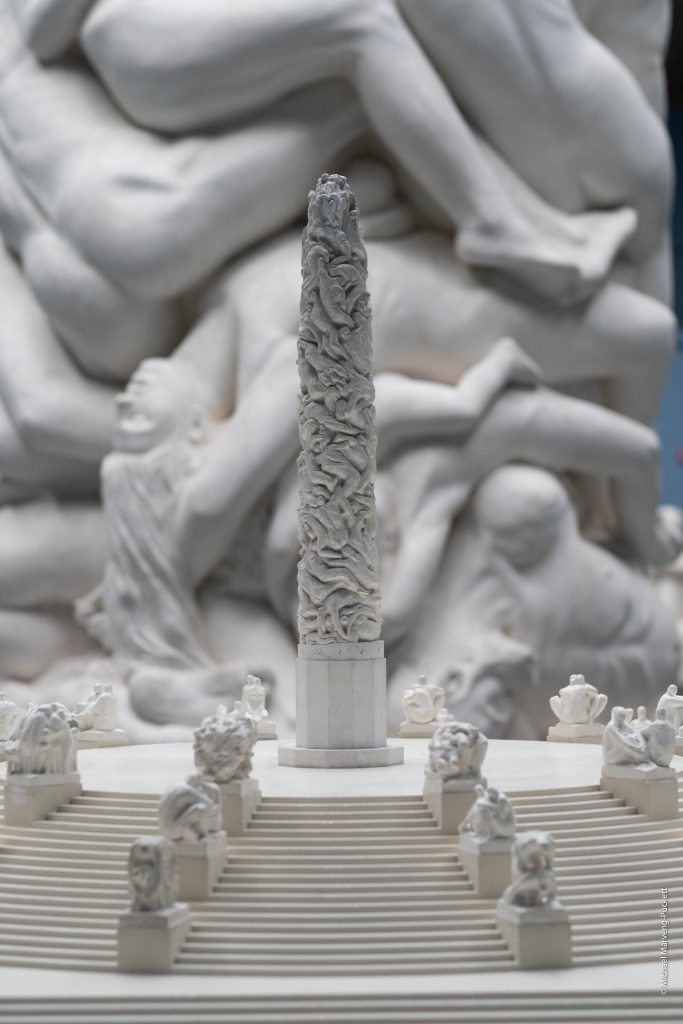 Michael assisted Eivind but also had the time to photograph some of the collection in the museum. Eivind had brought both extra lighting and a huge flash to make sure the lighting would be good enough. Above is the Monolith model for the park in front of the Monolith itself. “In the Monolith Hall stand several of the original plaster models to the 36 granite sculptures on the Monolith plateau, as well as the Monolith itself. This sculpture was carved in one piece (hence the name Monolith), but it was first modelled in clay, and then casted in plaster in three parts, as displayed in the museum today.”
Michael assisted Eivind but also had the time to photograph some of the collection in the museum. Eivind had brought both extra lighting and a huge flash to make sure the lighting would be good enough. Above is the Monolith model for the park in front of the Monolith itself. “In the Monolith Hall stand several of the original plaster models to the 36 granite sculptures on the Monolith plateau, as well as the Monolith itself. This sculpture was carved in one piece (hence the name Monolith), but it was first modelled in clay, and then casted in plaster in three parts, as displayed in the museum today.”
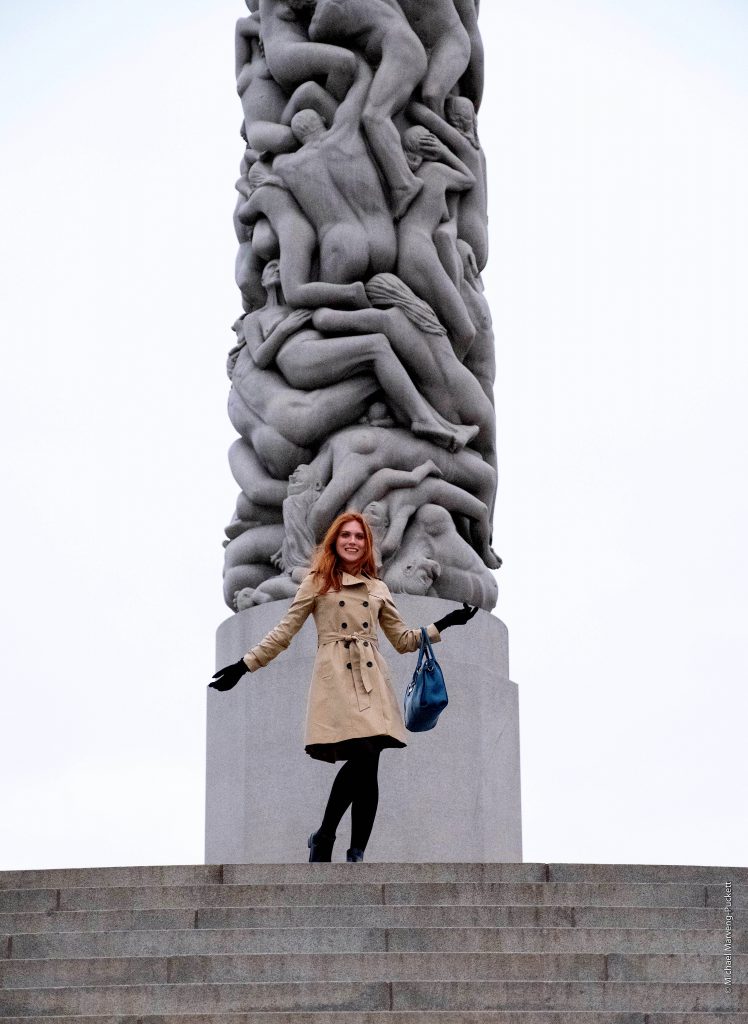 The Vigeland Museum is a popular venue for fashion shows, but also for concerts outside in the courtyard during the summer. The photoshoot was exhausting but also extremely rewarding and wonderful at the same time! After the shoot was a wrap – thanks to a brilliant team – and we had taken farewell with the curators and the security officer, we headed for the park, as Em has not had the time previously to see it. Above you see here in front of the Monolith in granite. Do visit both the park and the museum, when in Oslo, they are worth it. I will recapture our visit by choosing pictures from Eivind.
The Vigeland Museum is a popular venue for fashion shows, but also for concerts outside in the courtyard during the summer. The photoshoot was exhausting but also extremely rewarding and wonderful at the same time! After the shoot was a wrap – thanks to a brilliant team – and we had taken farewell with the curators and the security officer, we headed for the park, as Em has not had the time previously to see it. Above you see here in front of the Monolith in granite. Do visit both the park and the museum, when in Oslo, they are worth it. I will recapture our visit by choosing pictures from Eivind.
Eira Pullover Again
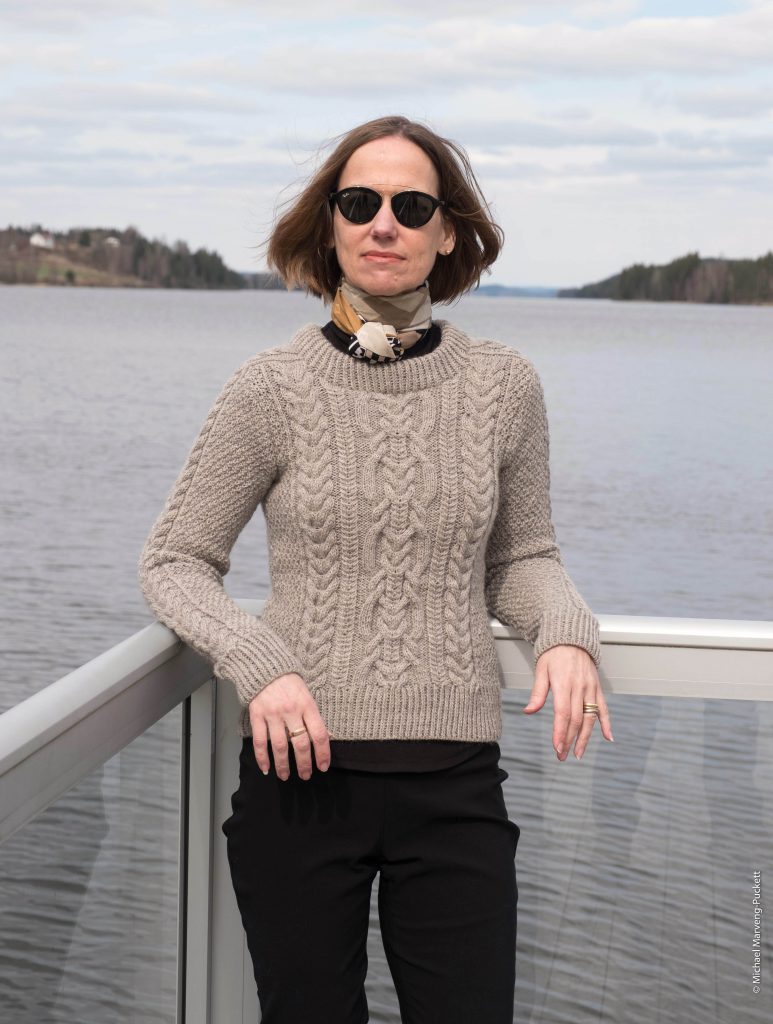 Yes, I know you have seen the Eira Pullover already, but you have not seen these photos taken by my husband in mid April at the Boat Café in Ørje. I am trying to look relaxed and warm but I was freezing even when I was wearing the Rørbye Cardigan on top. The Eira Pullover was made for knit.wear Fall/Winter 2017 and knitted in the wonderful The Fibre Co. Cumbria using a 4 mm/US 6 needle. Cumbria is made of 60% merino wool, 30% brown mash wool, 10% mohair, with 218 meters/238 yards per 100 gram skeins in the shade Scafell Pike. The gauge is 23 stitches and 28 rows in Moss stitch measures 10 cm/4″ square.
Yes, I know you have seen the Eira Pullover already, but you have not seen these photos taken by my husband in mid April at the Boat Café in Ørje. I am trying to look relaxed and warm but I was freezing even when I was wearing the Rørbye Cardigan on top. The Eira Pullover was made for knit.wear Fall/Winter 2017 and knitted in the wonderful The Fibre Co. Cumbria using a 4 mm/US 6 needle. Cumbria is made of 60% merino wool, 30% brown mash wool, 10% mohair, with 218 meters/238 yards per 100 gram skeins in the shade Scafell Pike. The gauge is 23 stitches and 28 rows in Moss stitch measures 10 cm/4″ square.
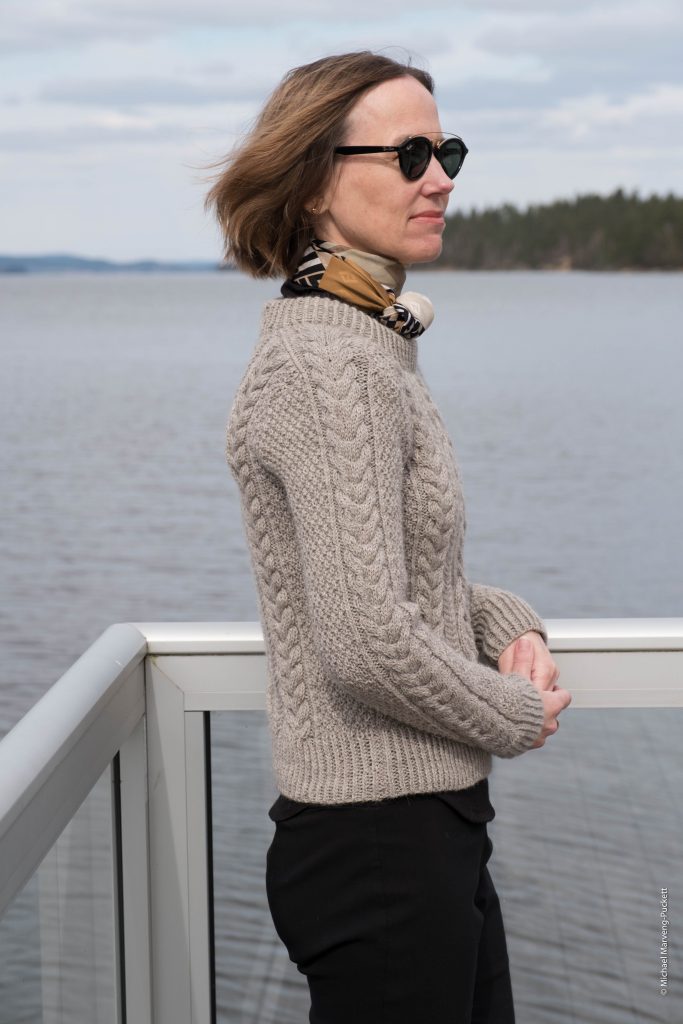 The working title was Kanik when I submitted it to the Winter Whites theme with the following description: A visually striking pullover that is both chic and comfortable, named Kanik; Eskimo for snowflake after the intricate center cable. The stunning cable adorns the center front and back and is framed by a braid on each side. While Seed stitch fills the background in the sides to allow the cables to shine, on this straight sweater. A saddle shoulder allows the staghorn sleeve cable to continue all the way to the neck.
The working title was Kanik when I submitted it to the Winter Whites theme with the following description: A visually striking pullover that is both chic and comfortable, named Kanik; Eskimo for snowflake after the intricate center cable. The stunning cable adorns the center front and back and is framed by a braid on each side. While Seed stitch fills the background in the sides to allow the cables to shine, on this straight sweater. A saddle shoulder allows the staghorn sleeve cable to continue all the way to the neck.
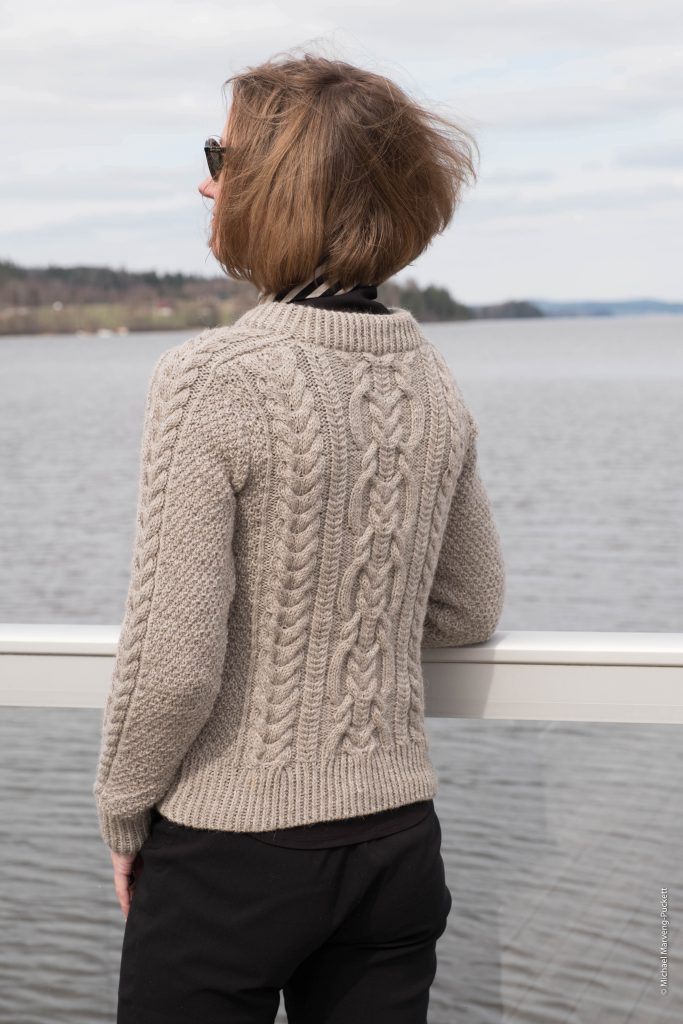 The sample is made in the smallest size with a 81 cm/32″ bust circumference and it is worn with zero ease. The largest size has a bust circumference of 123 cm/48.5″, and there are four sizes in between.The pullover is knitted flat and seamed in order to give it the best shape and support. Only the collar is worked in the round. Eira Pullover was the pattern of the week at the Interweave blog and here is what Assistant Editor of Knits, Gus Baxter writes: “Linda Marveng’s Eira Pullover from knit.wear Fall/Winter 2017 is a study in knitting cables. This project combines 3 wide cables, 2 narrow cables, and moss stitch. An eye-catching cable featuring wide arches, knots, and small braids dominates the center panel. Then columns of large staghorn cables flank the central panel and decorate the saddle sleeves: stitches undulate from the inside to the outside in an antler motif. Moss stitch, a classic complement to cabled designs, covers the sides and sleeves. Eira Pullover has the same patterning on front and back; it’s worked in pieces and seamed.”
The sample is made in the smallest size with a 81 cm/32″ bust circumference and it is worn with zero ease. The largest size has a bust circumference of 123 cm/48.5″, and there are four sizes in between.The pullover is knitted flat and seamed in order to give it the best shape and support. Only the collar is worked in the round. Eira Pullover was the pattern of the week at the Interweave blog and here is what Assistant Editor of Knits, Gus Baxter writes: “Linda Marveng’s Eira Pullover from knit.wear Fall/Winter 2017 is a study in knitting cables. This project combines 3 wide cables, 2 narrow cables, and moss stitch. An eye-catching cable featuring wide arches, knots, and small braids dominates the center panel. Then columns of large staghorn cables flank the central panel and decorate the saddle sleeves: stitches undulate from the inside to the outside in an antler motif. Moss stitch, a classic complement to cabled designs, covers the sides and sleeves. Eira Pullover has the same patterning on front and back; it’s worked in pieces and seamed.”
The knit.wear Fall/Winter 2017 is available in a digital edition and in a print edition. In Norway you can soon buy the magazine at the larger Narvesen kiosks or ask your local one to order it for you.
Eira Pullover and Rørbye Cardigan in knit.wear Fall/Winter 2017
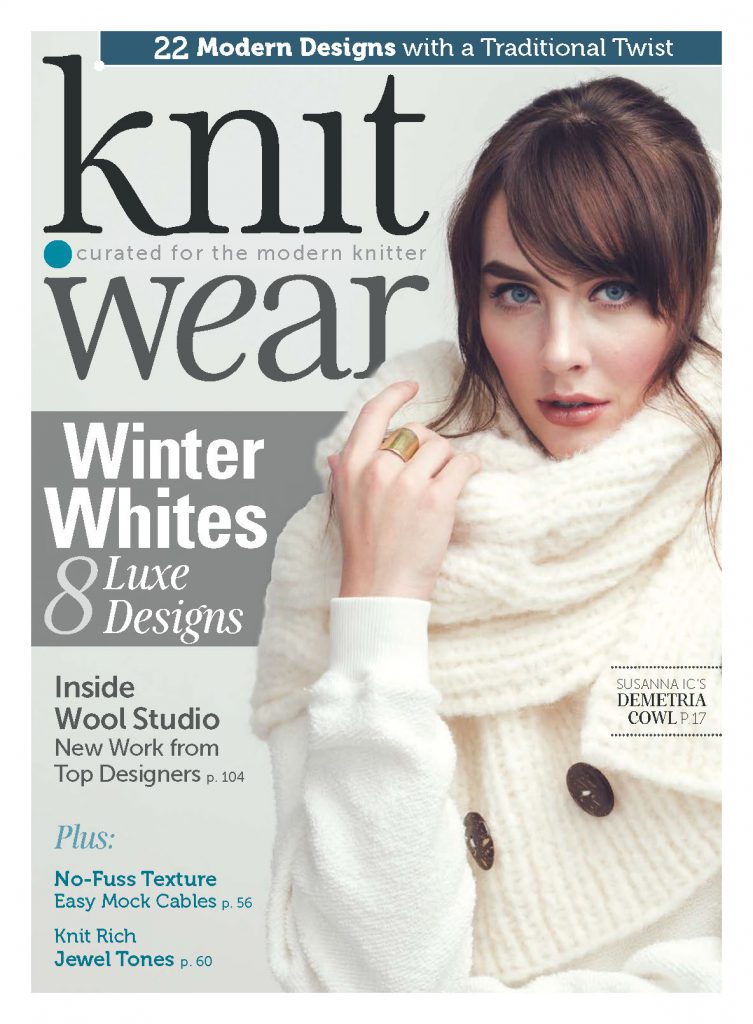 I am proud to present the 2 designs I have in the knit.wear Fall/Winter 2017 issue: Eira Pullover and Rørbye Cardigan. How could I decline when editor Meghan Babin wanted not only one but two of my designs for this issue? Despite our move coinciding with the deadline in April, I took the offer gladly (read: I did not ask my husband for his opinion). Of course I had some obstacles not only in the knitting of them but also during our move, but that is life. I submitted the Eira pullover as Kanik to the Winter Whites theme as follows: A visually striking pullover that is both chic and comfortable, named Kanik; Eskimo for snowflake after the intricate center cable. The stunning cable adorns the center front and back and is framed by a braid on each side. While Seed stitch fills the background in the sides to allow the cables to shine, on this straight sweater. A saddle shoulder allows the staghorn sleeve cable to continue all the way to the neck. Above is the cover with Susanna Ic’s Demetria Cowl on the cover.
I am proud to present the 2 designs I have in the knit.wear Fall/Winter 2017 issue: Eira Pullover and Rørbye Cardigan. How could I decline when editor Meghan Babin wanted not only one but two of my designs for this issue? Despite our move coinciding with the deadline in April, I took the offer gladly (read: I did not ask my husband for his opinion). Of course I had some obstacles not only in the knitting of them but also during our move, but that is life. I submitted the Eira pullover as Kanik to the Winter Whites theme as follows: A visually striking pullover that is both chic and comfortable, named Kanik; Eskimo for snowflake after the intricate center cable. The stunning cable adorns the center front and back and is framed by a braid on each side. While Seed stitch fills the background in the sides to allow the cables to shine, on this straight sweater. A saddle shoulder allows the staghorn sleeve cable to continue all the way to the neck. Above is the cover with Susanna Ic’s Demetria Cowl on the cover.
In the letter from the Editor, Meghan writes in “our Winter Whites story, we offer a clean slate for your exploration of cables and traditional techniques.” My Eira Pullover is knitted in the divine The Fibre Co. Cumbria made of 60% merino wool, 30% brown mash wool, 10% mohair, with 218 meters/238 yards per 100 gram skeins in the shade Scafell Pike using 4 mm/US 6 needles. The gauge is 23 stitches and 28 rows in Moss stitch measures 10 cm/4″ square.
The sample is made in the smallest size with a 81 cm/32″ bust circumference and it is worn with zero ease. The largest size has a bust circumference of 123 cm/48.5″, and there are four sizes in between.The pullover is knitted flat and seamed in order to give it the best shape and support. Only the collar is worked in the round.
I love the styling with the white trousers by Tina Gill and the hair & make up by Janie Rocek. These beautiful photos by Harper Point Photography do show it off so well. My other contribution is for the Cypress & Plum story. “Inspired by Dutch Master paintings of the Golden Era, you’ll find a canvas on which you can delve into rich jewel tones and exquisite fibres.” Rørbye Cardigan was submitted as Anuri: In a contemporary style with provocative visual lines – created by the sideways knitted cable panel to make a waterfall bottom – is this long cardigan. The body is all in stockinette stitch to offset the cables. Eventhe sleeve has a cable panel knitted sideways as a cuff. Anuri is Eskimo for wind, just as this long cardigan will blow around you.
The reversible cable is from Norah Gaughan’s excellent Knitted Cable Sourcebook. The reason the shoulder is worn so far out in the photo above is because the interfacing is worn flat and not folded as intended. The sample is knitted in Dale Garn Eco Wool made of 70% wool, 30% alpaca, 112 meters/122 yards per 50 g skein in 1233 grey green knitted using 4 mm/US 6. The cardigan shown is the second size and measures 46.5 cm/18.25″ back width on a model with a 86.5 cm/34″ bust. The smallest size has a back width of 44 cm/17.25″ and the largest 64.5 cm/25.5″, and three sizes in between.
The lower body of this cardigan is worked from side to side. The upper body is worked back and forth in one piece from the pick-up on the lower body to the underarm, then the upper fronts and back are worked separately. The sleeve cuffs are worked from side to side, then the sleeve is worked in the round to the underarm. The collar is worked back and forth in two pieces.
Here is the collar with the WS showing and you can clearly see the interfacing worked in rib. I did consider making the collar without the interfacing, but decided I wanted to be able to fold it back and also have the extra warmth it provides. The obstacles I had was the length of the upper body as well as sleeves. Both were too long so they had to be adjusted during finishing. There is always a risk involved when I am trying out a new silhouette and not certain about the length of each piece.
The back view shows 3 cables at the bottom and one at the top of the lower body. It does take a second to distinguish the single cable in the panel with the three. The cable is worked in rib and not as difficult to knit as it looks. There are a lot of wonderful designs in this issue and I am in great company! Thank you, knit.wear! The knit.wear Fall/Winter 2017 is available in a digital edition and in a print edition. In Norway you can soon buy the magazine at the larger Narvesen kiosks or ask your local one to order it for you. Photos of me wearing these designs taken at the beach in Ørje on a very cold April day is coming.

